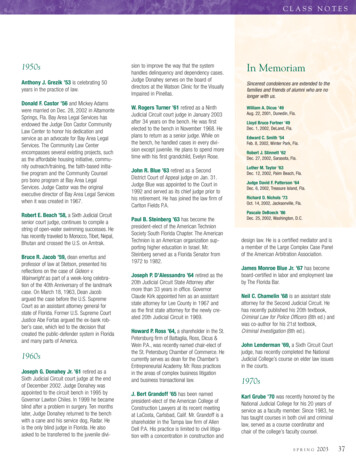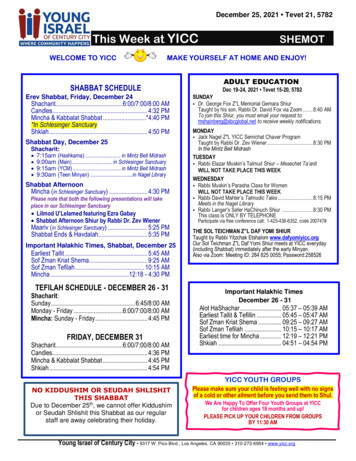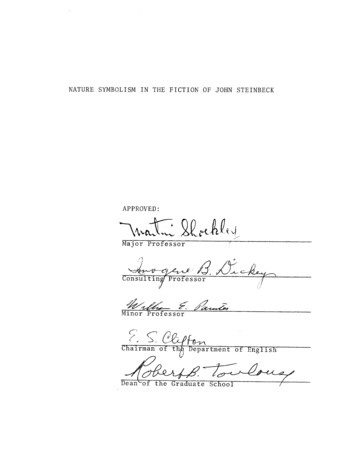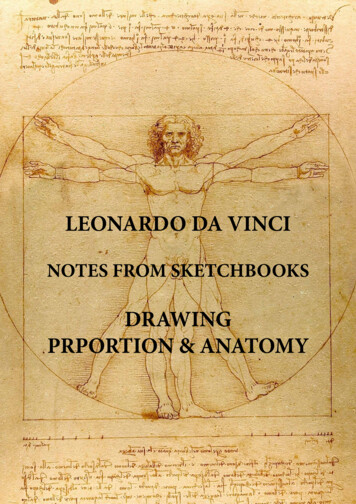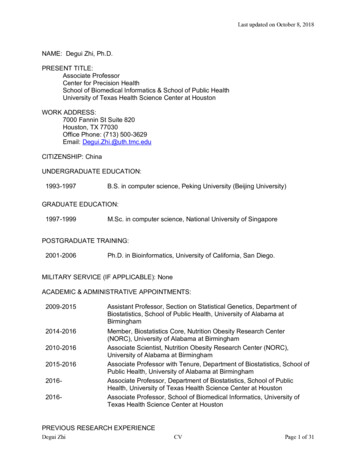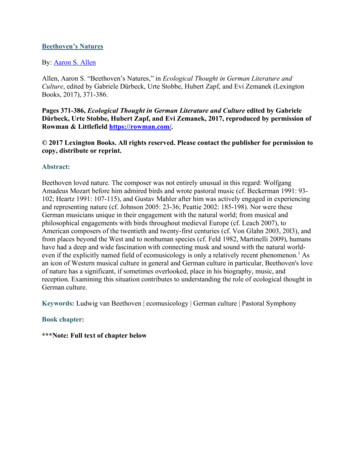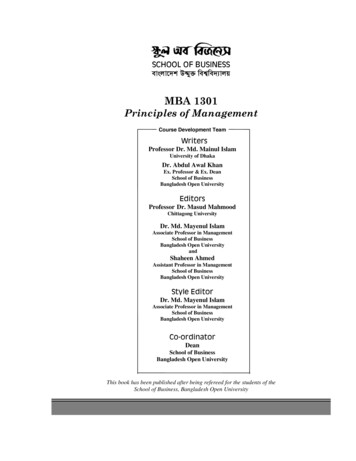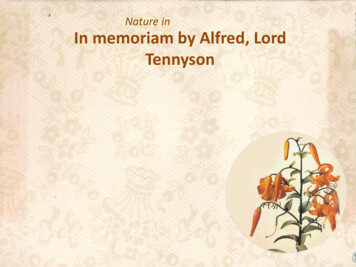
Transcription
Nature inIn memoriam by Alfred, LordTennyson
In Memoriam is a long poem written by the English poet Alfred, LordTennyson, and completed in 1849. It was composed as an elegy to hisfriend, Hallam, who died at the age of 22 from a fever. The poemconsists of many smaller poems, written in iambic tetrameter with anABBA rhyme scheme. Besides it is divided into 133 cantos (including theprologue and epilogue), and in contrast to its constant and regulatedmetrical form, it deals with different subjects such as: profound spiritualexperiences, nostalgic reminscence, philosophical speculation, Romanticfantasizing and even occasional verse. At the death of his best friend,Tennyson seeks to understand his senseless death with an exploration oflife's meaning. This one man's death spurs this epic elegy to theologicaland scientific discussions of the purpose of pain in life. In In Memoriamdoubt and faith become the key elements in the pursuit of a clearanswer from God. The man who inspired this pivotal poem was Hallam.
In Tennyson's In Memoriam, he utilizes many different aspectsof nature as metaphors to describe his emotions after the death ofa close friend. In writing the poem, Tennyson was influenced bythe ideas of evolution presented in Vestiges of the Natural Historyof Creation which had been published in 1844, and had caused astorm of controversy about the theological implications ofimpersonal nature functioning without direct divine intervention.Throughout the poem, the poet refers to many aspects of naturesuch as trees, water, and wind and so on and so forth. He projectshis emotions, whether sad or happy, on those natural elements.
In the beginning of Tennyson's poem, he describes an old yewtree. The tree, to him, is dead and at this early point of his grief hecannot find any life in the nature surrounding him. The old yew"which grapsest at the stones/ That name the underlying dead,/Thy fibers net the dreamless head,/ Thy roots are wrapped aboutthe bones" (2.1-4). Therefore he sees the tree as an extension ofthe graves it grew on. The roots are entangled around the deadbones and are as dead as the skull of the person, unable to dreamever again. The world around the tree and grave will begin againto bloom, but Tennyson feels the tree will not change and keep itsgloomy appearance throughout the year. He is "sick for thystubborn hardihood" (2.14) and seems to wish to be like the tree.For if he were also dead, he would not have to feel the pain he isexperiencing.
His natural surroundings are quiet, which he feels are suited to thisstage in his grief. It is fall and the leaves are falling off the tree along withthe chestnuts. Still there is imagery of death and dying. It is quiet but theworld to him is dying. A particular moving part of the poem is when hedescribes a dam. The dam slows down and "hushes half the babblingWye" (19.6) and he feels his grief is stopped up also. He still feels deepgrief, but he controls himself at most times. The tide makes the waterflow again and floods the surrounding area with noise. Like the flood ofwater is the flood of his tears where his deepest anguish bursts out ofcontrol and he cannot contain his feelings. In contrast to his earlier feelingof wanting to be like the inanimate and unfeeling as the old yew tree,Tennyson pities animals that cannot feel. "I envy not the beast thattakes.To whom a conscience never wakes" (27.5-9).He makes remarkable progress in his healing. It is as if he is coming to terms with whathappened. "'Tis better to have loved and lost/ Than never to have loved at all" (14-15). Inthe mists of heavy grief this is certainly a difficult thing to say. Some time has gone byand Tennyson reconsiders the yew tree. He finds when he taps at it, pollen spurts out."these buried bones.With fruitful cloud and living smoke." (39.1-3). So he discovers thelife within the tree that he did not believe existed back in the fall at the beginning of hisbereavement. Throughout his exploration of his friends death, Tennyson questions theexistence of God. "What then were God to such as I" (34.9)? Through his observation ofnature he seems to accept the existence of God. "That nothing walks with aimless feet;/That not one life shall be destroyed.That not a worm is cloven in vain;/ That not a mothwith vain desire." (54.5-10).
He views even the smallest creatures with having a purpose. Thereforehis friends life held purpose and his death was not in vain. He stillstruggles with God and nature though. He wonders "Are God and Naturethen at strife." (55.5). He sees nature as destructive, bringing to fruit justone seed out of fifty. He wonders how God and nature co-exist. Naturedoes not care specifically for life. She brings life and death, as for thespirit--that is for God. So he gropes "To what I feel is Lord of all,/ andfaintly trust the larger hope" (55.18-19). At this point he has mixedemotions. He sees the re-birth and hope for life in nature but he also seesthe destructiveness of nature. After the one year anniversary of Hallam'sdeath, Tennyson looks forward to spring. "O sweet new-year delayinglong;/ Thou doest expectant nature wrong.Can troubles live with Aprildays,/ Or sadness in the summer moons" (83.2-8)? So he is lookingforward to having the earth re-awaken and come alive. He feels the energyand life of spring will help him with his sadness. Being surrounded by suchactivity makes it hard for one to be depressed. Not only is the earth beingreborn but his spirit is also.He sees his grief as causing him to doubt God, but all along he knewthat God was there. Tennyson realizes that God cannot be completelyunderstandable to man. He also sees nature as a force of God, somethingthat God uses to make men. God through nature helps men understandthemselves, their life and death.
There is throughout the poem a nonlinear narration, due to the cycletechnique used by Tennyson in order to illustrate certain fundamental lawsbehind human time and natural time, Tennyson’s notions of time are initiallydependent upon the strict division between human time and time existing innature, the first is linear, the second one is cyclical. This concept is exposed inSection 22. In section 22 it is described a sort of experience of the author andHallam that consists in a fall out of natural or seasonal time, they coexist with thenatural passing of the seasons and at the end this cyclical time changes into amore linear time endowed by the immanence of death, represented by "theShadow"; it is more explicit in another verse this concept of seasonal time "Andevery winter change to spring" in section 54 line 16. In my opinion winterrepresents the death of nature, but the difference is that nature regenerates,whereas human being only dies. I agree with the opinion that Tennyson,throughout the poem, tries to reconcile the natural time with the human time,but I think that he cannot.‘And we with singing cheer'd the way,And, crown'd with all the season lent,From April on to April went,And glad at heart from May to May:’
Tennyson crafts a woman to represent nature, but "she cries from cliff-top", she is nota nurturer who will not betray but one who cares for nothing, Tennyson’s woman doesnot feed human mind, that is to say nature does not teach anything to the poet, it is notthe source for the poet’s imagination.‘That Nature lends such evil dreams?So careful of the type she seems,So careless of the single life;’He says that Nature does not care about the human subject, as a lot of subjects havepassed by and have gone after his existence. The verses of this stanza are written as ifthose were Nature's words on the issue. As if it was Nature herself who was talking to usAnd Tennyson's ideas on Nature as an evil being, as a destructive force, ideas explainedin the next section of this research, are well reflected in this stanza.In the second stanza Nature continues speaking and expressesher power to give and take away life at her will, an action that hasto be done without having on account anything else but herdesire and no reason at all. The final verse of this second stanzalinks with the beginning of the third one where the idea of manas Nature's last work, is expressed. This idea of man as the lastwork of creation brings to my memory the Christian theory of thecreation of the world, in which God created the man after havingcreated the world, the scenery where man was to be set. But inthis case the creator is Nature instead of God.
Water is a dominant image throughout the text of In Memoriam that isemployed by Tennyson to relate his emotional and intellectual state to thereader as he struggles to come to grips with the loss of his friend, ArthurHenry Hallam. His use of water imagery is not strictly limited to the body of InMemoriam however, and, examining all of his works, we see that it has been aconstant yet dynamic image throughout his entire career, and that it isrepetitively employed with various intended meanings. In Memoriam ,besides being his greatest work, also has the distinction of being the work inwhich the intentions behind Tennyson's water imagery undergo a dramaticshift from carrying an overall negative connotation to a much more positiveone - a shift that is made entirely possible through the language that heemploys in their depiction. In Memoriam highlights Tennyson's use of waterimagery and shows how, through the use of simple yet multi-layeredlanguage, he shapes this constant, familiar image over and over again.Tennyson seems exceptionally strong in his ability to use a variety of formsof nature to achieve his point. He demonstrates that man and nature arebound together on earth. Tennyson seems to be the poet who has achievedthe most reconciliation with nature imagery and his poetry.
lpme.com/view.asp?id 20118http://en.wikipedia.org/wiki/In Memoriam A.H.H.#Nature.2C Red in Toothand Claw
life's meaning. This one man's death spurs this epic elegy to theological and scientific discussions of the purpose of pain in life. In In Memoriam doubt and faith become the key elements in the pursuit of a clear answer from God. The man wh
